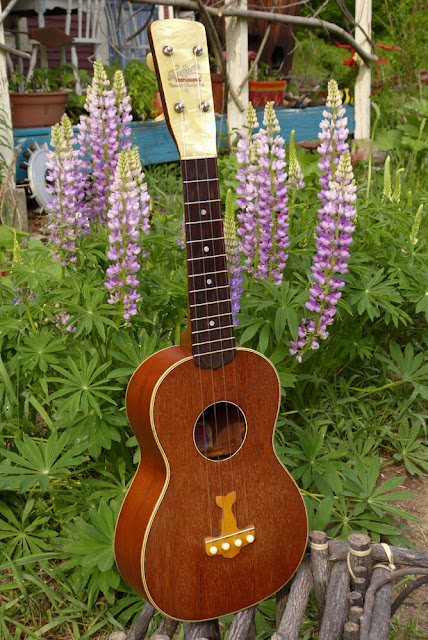1930s Harmony Airplane-Bridge Johnny Marvin "Tenor" Ukulele
"Back in the day," Johnny Marvin was a big-name uke-strummer. Now he's mostly remembered for these wonderful ukes that bear his name. The most common version is sunburst and fairly traditional for a concert-sized uke of the day. The nicer (and more desirable) ones have the Harmony "Lindbergh" (airplane) bridge, lighter bracing, and a bigger tone. This is one of the latter type, though it has a bunch of (repaired) cracks and has been refinished on the back of the neck and top-coated with finish on at least the back and top of the body.
When fixed-up, these have a lovely, full, and rich voice that's something like a "turbo" version of a Martin soprano sound -- mellow, sweet, but lively. It's not at all like the more "sparkly" and very-defined concert Martin sound. They're loud and feel like they say on the headstock -- "Professional" -- which means that for group use they work very well.
The body is solid mahogany and the neck is, too. It's super-lightly braced (like a lot of nicer-grade Harmony ukes are) and has a very thin top (which is why is sounds so good).
Work on this included cleating a lot of cracks, regluing all the braces, a fret level/dress, bridge shave/refinish/and reglue, new pins, a new fret-style saddle, general cleaning, and setup. It plays on-the-dot with 1/16" action at the 12th fret. This only has a 14 3/4" scale length, too, so the feel is in-between a modern concert (15" to 16") and a modern soprano (usually 13 5/8" or so).
A generous nut width and thin (front to back) C-shaped neck make this an easy player that's especially suited to someone who fingerpicks or plays complex chord shapes -- there's plenty of string spacing to get around on.
The headstock veneer in pearloid is pretty classic. Ironically, it states "tenor" ukulele, but the scale and size is definitely concert. The nut is bone and original.
The fretboard is a thin veneer of Brazilian rosewood and the dots are pearl. The frets are original nickel-silver uke-size stock.
The top, back, and soundhole are edged in binding.
The original airplane bridge needed regluing and reprofiling. I shaved it down, some, and then sprayed it with an amber-colored nitro finish to get it back to the aged-in yellow color it was to begin with. The pins are parts-bin old plastic to replace the (some-missing) original bone pins.
I used a fret-saddle because I didn't want to put a bigger slot in a thinned-up bridge and... I also like fret saddles on ukes!
The strings are fluorocarbon.
The back of the neck looks like it's been entirely refinished, though the body is the right "tint" for an original "natural finish" Johnny Marvin, but the top/back have definitely had some brushed-on top-coating. The look isn't bad -- just "well-loved."
The biggest crack was a long separated bit on the back lower-bout. Finagling brought it all together and got it filled-in and good-to-go.
The original tuners are nice units, but I fit them with some extra washers below their rear portion to get them to work even better. They're simple friction pegs but look great and have ivoroid buttons.
Here's that crack in detail.
Here's another one -- a hairline -- on the upper-bout rear. All of the cracks have been dealt-with.
Because they're hard to see, I took this glared shot to show the cracks on the front (all repaired). There are two to the treble side of the bridge and two under it.
There's also this one to the side of the soundhole.
They're not as obvious in regular lighting, but they're there.
Here's an old repair to a side crack. My only work on this one was to lightly fill it in and seal it in a couple spots.
The original, ragged, case comes with it. I'm going to duct-tape the heck out of the edging on it.






















Comments